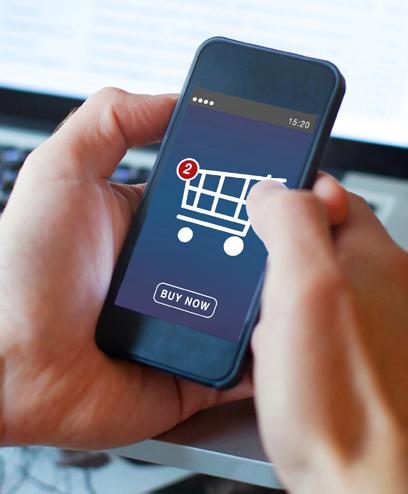GUIDE TO ECOMMERCE TECHNOLOGY
YOUR
October 2022 modernretail.co.uk ADVANCING ECOMMERCE WITH TECHNOLOGY







PUBLICATION BROUGHT TO YOU BY TAKE YOUR BUSINESS TO THE NEXT LEVEL Whitehouse Solutions can help your eCommerce business save time and money with professional order fulfilment Fully integrated with major eCommerce platforms… Call 01787 471487 today and find out how easily and quickly we can help with your distribution Years of experience in fashion, food, retail, gift, print and wholesale markets A friendly and personal service for start ups to large online retailers Free up space and keep your stock safe in our secure warehouse Save time and meet seasonal demands with efficient pick, pack & despatch Benefit from reduced courier rates £ hello@whitehouse-solutions.co.uk whitehouse-solutions.co.uk
Retail Brands Prioritise Digital Quality to Attract and Retain Customers
Embracing Ecommerce Integration to Ride the Black Friday Retail Wave
Striking the Right Chord: How to Succeed with Composable Commerce
Reduce Cost Pressures with Automation this Peak Season
To Know Them is to Serve Them
The Hidden Opportunity in Returns
Crossing the Communications Divide
Why Less May be More for Effective Digital Marketing
How to Create a Seamless Checkout
Are Inflexible BNPL Solutions
Content Editor
Holly Worthington
Holly brings a wealth of experience in both print and digital publishing. As Modern Retail’s Content Editor, Holly is passionate about helping independent retailers to thrive in today’s ever-changing market.
Credits
Managing Editor
Rob Gamage - rob@modernretail.co.uk
Content Editor
Holly Worthington - holly@modernretail.co.uk

Business Development Manager
Emma Mjekiqi - emma@modernretail.co.uk
Thanks
Many thanks to all those who provided editorial content or images, helping us to compile what we hope is a useful and informative read! Please send any comments or suggestions to rob@modernretail.co.uk.
Modern Retail is published by Considered Digital Ltd (Registered Company Number 12684643). Registered office address: 39 The Metro Centre, Tolpits Lane, Watford, Hertfordshire, United Kingdom, WD18 9SB.
PUBLICATION BROUGHT TO YOU BY 3 CONTENTS
Holding Your Business Back? 04 06 10 12 14 16 18 20 22 24
RETAIL BRANDS PRIORITISE DIGITAL QUALITY
TO ATTRACT AND RETAIN CUSTOMERS.
Brands prioritise digital quality to attract & retain customers
Customer spending on retail goods is becoming more discretionary due to rising inflation and living costs. Retailers are responding to this by improving the quality of experience across their sales channels, paying close attention to enhancing the digital experience. Retailers understand the high stakes at play when it comes to their customers and the exceptional experiences they have come to demand.
During the pandemic, customers became heavily reliant on using technology and digital platforms within the customer journey. Retailers are fully aware of this shift and customers’ continued preference for online channels:

circle Buy online, pickup in store (BOPIS)
circle Buy online, ship-to-store (BOSS) circle Curbside pickup
circle Buy online, return-to-store (BORIS) circle Buy online, deliver-to-home
Retailers are making significant investments to meet current and future e-commerce needs. This doesn’t mean they’re neglecting more traditional retail experiences. Instead, they are working to ensure greater consistency and continuity of experience across bricks and mortar shops, online and the omnichannel experiences.
So, how do retailers maintain high standards in digital quality to attract and retain customers? Software quality is critical, along with testing the end-to-end journey across both digital and physical channels to uncover points of friction in the customer journey prior to releasing to actual customers, to ensure a high-quality shopping experience
Digital quality delivers business value
Retailers that invest in innovation, intuitive user experiences, and seamless customer journeys quickly capture serious returns. They experience increased market share, faster time to market, better customer retention and satisfaction, higher average sales, and other benefits that link back to revenue.
To better understand the role of digital quality in today’s business environment, it would be useful to look at the key findings of a recent report that analysed retail testing data over a year, spanning 100+ countries, to identify common points of friction within the customer journey.
More than 57,000 retail bugs were found. The report evaluated five different bug types: content, crash, functional (workflow errors), lags and latency, and visual. Up to three-quarters (73.5%) were functional bugs. It’s not surprising as retailers continue to adopt and integrate nascent technologies. VR, AI, ML, smart home, voice, as well as the rise of m-commerce, mean that retailers are navigating the omnichannel landscape, often juggling entirely different technologies at once.
Cart abandonment is a huge problem for retailers
Retail workflow errors were discovered to be the most common flaws. These bugs prevent shoppers from completing their desired tasks. Whether a customer is searching a site for items to purchase, trying to access an online chatbot or customer service rep for assistance, or checking out, they expect to complete the “shop and buy” journey without any glitches.
PUBLICATION BROUGHT TO YOU BY4
“Retailers are responding to this by improving the quality of experience across their sales channels, paying close attention to enhancing the digital experience...”
Forward-looking retailers have found that improving quality consistently pays off in cost savings, faster releases, and increased customer satisfaction and retention.
With cart abandonment rates lingering around 70% (depending on the study) for desktop customer experiences, and mobile app cart abandonment climbing into the 80% range, retailers can’t afford any friction that will increase the odds of a customer abandoning the shopping experience. For example, testing for mobile — which must include things like checking mobile site speed, keeping key content elements above the fold, better menu management on a smaller screen, and ensuring secure, reliable payment options — must be done with real shoppers in any markets in which your brand exists, checking not only for key functionality, but also for accurate localization of content
Closing the digital accessibility gap
Retailers must focus on catering for the needs of people with disabilities (PwD), such as blindness, low vision, auditory challenges, mobility challenges, and neurodiversity. That said, all digital channels should provide an inclusive experience for everyone, regardless of ability. Inclusive design relies on adopting a human-centric approach to software development. It should be about
much more than adhering to accessibility guidelines; it should cover every aspect that could affect an individual’s ability to have a seamless experience.
This approach will ensure that inclusivity begins at the design stage and continues through ongoing real-world testing, in which real feedback is gathered from real PwD. Ongoing inclusive testing is essential to ensuring that every step of product development or the customer journey is fully accessible to all users.
Constant innovation and realworld testing will remove friction
As a retailer in this highly complex environment, how do you ensure that all customer and prospect touchpoints with your brands are frictionless and top-notch?
Only a diverse set of testers who match your customer profiles can help you create the best shopping experiences. And these testers must represent the people in the markets in which you sell or hope to sell.
Forward-looking retailers have found that
improving quality consistently pays off in cost savings, faster releases, and increased customer satisfaction and retention. In a world of economic uncertainty, rapidly evolving technologies and heightened customer expectations, retailers can’t afford to be complacent about digital quality.

Contributor:
Carlton Retland, Principal Solutions Engineer Applause

PUBLICATION BROUGHT TO YOU BY 5
EMBRACING ECOMMERCE INTEGRATION TO RIDE THE BLACK FRIDAY RETAIL WAVE

Whether you are starting out, fully established or looking to scale your business, designing an infrastructure and having processes which work is essential to reliable and cost-effective deliveries.
These key points should be considered when planning your order fulfilment strategy.
Challenges for optimising sales on BFCM
As the success of a brand depends entirely on remarkable customer experience, BFCM is also the biggest test in the retail calendar. Smart retailers realise they need to take advantage of dedicated technology to secure sales and boost revenue. But many retailers are distracted by the minefield of shiny new tech and experience confusion over which tech to invest in, while others are concerned about the quality of their data and whether they can integrate their existing systems to improve ecommerce processes.
can shrug this off, these challenges often correlate to loss of customer sales and loyalty, such as cart abandonment. Any weaknesses that haven’t already surfaced will be amplified during this time, putting their business performance and reputation on the line.
Top BFCM trends to be aware of
Contributor: Eduardo Silva, Chief Revenue Officer. Patchworks

When a retailer’s data isn’t shared seamlessly as part of an omnichannel approach, via integrating all channels to a customer, this can create friction in various areas. While business leaders
It’s no accident that during November 2021, Patchworks processed an average of 42% more customer orders than in any other calendar month that year. Investing in the right technology to harness ecommerce systems, and generating the right insight from data, sets retailers on a clear path to success. But it’s not all about technology - in preparing for BFCM, brands need to keep an eye on the biggest trends in the industry to maximise chances of success:
Retailers need to make sure they’ve laid the groundwork. This means looking at customer and product data and insights from previous years to inform tactical decisions.
1. Insuring against stock shortages
Stock issues are a major risk for retailers and something that is all too easily avoided. News stories on stores selling out rapidly placed this issue in the spotlight in 2021, and there were significant stock shortages, some of which continued into 2022. Certain sectors, such as electronics, faced huge demand for newly released and highly popular games consoles such as the Xbox Series X and PlayStation 5. Lack of order fulfilment and poor communication throughout the purchasing process is a major concern for consumers, and a huge risk for retailers - as trust is critical to customer loyalty. Brand reputation can be damaged in an instant on social media – for the long term.
2. Finding new ways to encourage customers to keep shopping online post-pandemic
As an ecommerce retailer, not attempting to take advantage of this time to cross and upsell to customers is more than a missed opportunity. With an increase of up to 42% on a typical month’s sales to be realised, most retailers can’t afford to waive the opportunity to boost transactions. Businesses may therefore instead choose to focus on placing their flagship deals on products which are at lower risk of being held up in the supply chain. They may not be as popular, but overselling products during BFCM and having to issue hundreds of apologies and refunds is far more damaging to the bottom line than playing it safe.
3. Consider in-demand products from last BFCM
It’s worth considering that last holiday season’s out-of-stock products may perform well only a year later. Offering shoppers a Black Friday deal on a new, expensive item like games consoles and other electronics could still be an intelligent decision. With so many disappointed customers failing to buy their desired products over BFCM, many of those products which went out of stock may see an even bigger sale this time around to encourage people to make a purchase.
4. Keep a focus on in-store shopping
With ecommerce sales growing 50% over the pandemic, the convenience of online shopping has driven popularity.
Yet in 2021, in-store held huge value for retailers, as Black Friday UK high street shopper traffic saw a +35% uplift week-on-week. Therefore, brands which use technology to connect their offline and online experiences as part of an omnichannel strategy will be the winners. Furthermore, brands that use online customer engagement to drive shoppers to an in-person experience could trump those who don’t, as store visitor figures may be even higher this BFCM.
5. Shopping may be spread over the holiday months
As retailers have begun to extend this cyber retail week even further to gain an advantage over competitors, many sales start much earlier than Black Friday itself.
And it’s not necessarily on one single day that shoppers do all of their shopping, as ecommerce offers more flexibility than physical stores to spread shopping out in the lead up to Christmas. In fact, in 2021 only 30% of shoppers said they planned to do their shopping on Black Friday, whilst 45% said they planned to start it in September and in the run-up to BFCM – a trend which looks set to continue in 2022.
Cart abandonment is a huge problem for retailers
A BFCM ecommerce strategy will need planning or refining every year and there are three key steps. The first for retailers is an analysis of key trends, to take a close look at customers’ purchasing habits and identify what will motivate them to spend on this sale versus competitors. Creating an intelligent data-driven and targeted campaign is imperative.
The second step is to get their retail technology estate in order. This means ensuring infrastructure is sturdy and scalable, and that the website stands up firmly against the pressure of even standard traffic.
Third is building an effective tech stack, comprised of best-of-breed solutions which must be optimised for the business’ objectives. For instance, if customers are more likely to respond to SMS reminders over email, integrating an email marketing automation system isn’t the way to go.
Connecting systems, data and insight
By this point, the retailer is ideally positioned to invest in the right ecommerce integration platform. This platform can connect hundreds of apps and ecommerce systems, and send data between the shop front, ERP, warehouse, logistics, CRM, finance, EPOS, and marketplace systems, allowing businesses to simplify the integration of their technology stack. It’s best to choose a platform which empowers the retailer to take control of its own integrations through a selfserve dashboard and no-code/low-code capabilities so that they can get it up and running quickly and easily.
Since effective stock and inventory management is critical to delivering for customers’ expectations around BFCM, it’s vital to invest in a solution to more accurately record stock and process orders. Connecting all stores across all ecommerce platforms ensures that stock is managed effectively, and retailers can offer live updates when inventory levels change and items sell out. Stock management is about more than just overselling. If an item is underperforming in one store but selling out in another, stock can be shipped to where it’s needed to boost the bottom line.
Most important of all - when planning a BFCM sale, retailers need to make sure they’ve laid the groundwork. This means looking at customer and product data and insights from previous years to inform tactical decisions. Only in connecting systems, data and insight retailers will move the needle on sales and customer loyalty.
PUBLICATION BROUGHT TO YOU BY 7



PUBLICATION BROUGHT TO YOU BY8
PUBLICATION BROUGHT TO YOU BY 9 Sign up for 60 day free trial at shipstation.com with code MR2 Gain complete control and insight into all of your orders from one platform. Order Management View all stock levels, set inventory alerts, or allocate stock all while Inventory Management the best rate, print a label, or batch orders for rapid label creation. Delivery Management Create a more personalised and memorable delivery experience for your customers, at no additional cost. Branding
STRIKING THE RIGHT CHORD: HOW TO SUCCEED WITH COMPOSABLE COMMERCE
Replatforming to a composable commerce architecture can be a daunting task, but a good Product Information Management (PIM) solution can help you manage, clean, and scale your product data across every existing and new channel, says James Barlow, Regional Director, UK&I at Akeneo.
Brands and retailers that quickly and effectively optimised their online presence in the last two years captured the largest share of a market that has shifted online dramatically. However, there is still lots of work to do; in trying to keep up with a growing number of digitally-led sales channels, dealing with supply chain disruptions and changes in working culture, there is a greater risk of miscommunication and misinformation.
In response, many organisations are transitioning to a new commerce technology architecture that provides the flexibility, agility and omnichannel activation that they’re looking for. This is known as Composable Commerce (or Headless), a modular, best-of-breed approach to commerce technology that enables teams to effectively communicate across every aspect of the business.
By using individual applications to handle each specific aspect of the overall shopping experience, the team can ensure that every channel is optimised. Without having to upgrade the entire back-end infrastructure with every new update, composable commerce enables brands and retailers to implement new features across every single channel in an agile fashion, unlocking brand new shopping experiences for the consumer and better placing them to adapt to new and evolving opportunities in the market more quickly.
Despite the benefits of composable commerce architecture, replatforming can be a daunting task and success depends on having clean data and product information that flows through every single one of those modular applications. Product data must be well-structured, consistent, complete, accurate (and of course, compelling) to be handled reliably across those applications according to the channel or front-end experience.
The first step in replatforming to a headless architecture is to implement a Product Information Management (PIM) solution, which provides a central repository and single source of truth for product information to simplify communication across any channel, regardless of who owns it. It is the single best way to ensure that product data is as accurate and up-to-date as possible and enables the team to create the best product experience for end-users.
However, not all PIM solutions are created equally, and there are a few key factors to consider when selecting a solution to de-risk an ecommerce replatforming project. Firstly, the team should be looking for a cloud-native SaaS application that is dependable, secure, and scalable. This is a key tenet of a composable commerce architecture: PIM applications that are merely onpremise software hosted with a cloud infrastructure provider may not provide
PUBLICATION BROUGHT TO YOU BY10
the required scale and reliability.
Secondly, composable commerce architectures are built around Application Programming Interfaces (APIs), so a PIM solution simply has to be API-first with services that are available in a number of different ways and can scale as needed. A PIM solution that is integrated with a composable commerce platform needs to be able to handle massive amounts of API calls and all the SKUs in both current and future catalogues. This should mean confidently handling tens of thousands of API calls per hour and millions of SKUs.
Lastly, the PIM solution needs to be able to support all the new channels that a composable commerce architecture will open up. As the business grows on new and future channels, markets, and locales, the team will want to avoid wasting time recreating product information and content just for those new channels, markets, and locales that have their own specific requirements.
Some ecommerce platforms have a built-in tool for managing products in the catalogue, but they are typically limited in scope and intended for managing the catalogue sold on the owned ecommerce site. This won’t be enough to manage expansion into other owned and unowned channels. A modern PIM supports true omnichannel
shopping, providing capabilities to enrich information and product across all channels (and markets and locales) efficiently, without having to recreate attributes and content for each one, both today and in the future.

So, in order to truly support a composable commerce architecture, the team needs a PIM solution that is wellstructured and scalable, while ensuring the product experiences that customers have are consistent, complete, and compelling. A good PIM solution will make it easier to gather your data into one single source of truth, enrich product information, and put it in the proper context for both new and existing channels.
It should also act as a tool to help create and manage high-quality digital assets such as photos, videos, and anything else needed to win over ecommerce shoppers. Once product experience and information management are up to par, replatforming to a headless architecture becomes significantly less risky and gives the team more chances to convert customers by accelerating time-to-market and boosting enrichment efficiency.
By centralising and cleaning up all product data into a single source of truth, a good PIM solution unlocks unprecedented growth opportunities by getting products to market more

quickly, providing an unparalleled product experience to consumers, and helping to raise ecommerce revenue. Retailers and brands can also be more flexible, adaptable, and responsive to changes in the supply chain or sudden shifts in market trends. Migrating to a composable commerce architecture is the best way to avoid getting left behind in this ever-evolving, digital-first market, and just like a house, that replatforming project needs to start with a solid foundation; clean product data inside a sturdy PIM solution ready to scale.
Akeneo will be showcasing their PIM solution at the MACH One Conference, which is hosted by the MACH Alliance in London on the 28th & 29th June. Launched in 2020, the MACH Alliance champions open, best-of-breed technology ecosystems and its mission is to future-proof and propel current and future digital experiences with open and connected enterprise technology. Akeneo became a certified member of the MACH Alliance in March 2022, based on its best-in-class ecosystem that provides flexibility and openness as a key differentiator and driver of competitive advantage.
Contributor:
James Barlow, Regional Director, UK&I Akeneo
PUBLICATION BROUGHT TO YOU BY 11
REDUCE COST PRESSURES WITH AUTOMATION THIS PEAK SEASON
Peak Season - Impacts from the Cost-of-Living Crisis
Households across the UK haven’t had a break. The last three years have seen consumers navigating one crisis to another. Beginning with the shift in consumer shopping behaviours stemming from the pandemic to the current costof-living crisis, peak seasons haven’t been ‘normal’ for quite some time.
To help ecommerce retailers plan for the upcoming peak season, ShipStation have released their latest consumer report in partnership with Retail Economics. They surveyed over 8,000 shoppers to find out how households across the UK planned to shop this upcoming peak season, and the results are in.
Inflation Impacts on Buying Behaviours
It’s beginning to sound like a broken record. And it’s because of this uncertainty that peak season stands to be substantially impacted. After speaking with 6,000 shoppers, here are a few of the consequences we expect this peak season.
According to our recent survey, the UK is set to be one of the countries whose peak season will be severely impacted by the ongoing economic crisis. Of those surveyed, most said they are worried about rising costs and their impact on financial stability. The data also indicates that 40% of all those surveyed would cut back on all spending over Black Friday and Cyber Monday due to the cost-of-living crisis. The remaining 30% said they had no plans to change their shopping habits.
Additionally, the majority of those surveyed said they planned to do most, if not all, of their shopping this holiday season online. Whilst numbers are sure to be down; this is good news for eCommerce retailers.

The responses to our consumer survey indicate most households (over 70%) plan to cut back on some, if not all, of their spending. Of those surveyed, only 15% aren’t worried about the cost-of-living crisis - at least not right now.
As the inflation rate continues to rise, we are seeing an evolution of buying behaviours in households of all sizes. In August 2022, UK inflation hit 10.1%, numbers not seen since pre-1982. To better understand this, we look at how UK households plan to respond to the cost-of-living crisis.
The responses to our consumer survey indicate most households (over 70%) plan to cut back on some, if not all, of their spending. Of those surveyed, only 15% aren’t worried about the cost-of-living crisis - at least not right now.
In terms of peak season and incoming impacts on ecommerce retailers, here’s what we’ve learned from shoppers:
• Over 25% of UK consumers plan to do all their peak season shopping online
Reduce Cost Pressures with Automation

The UK’s economic future is anything but clear as we head into peak season. And it’s not just consumers who are sufferingretailers are also feeling the pinch. According to our research, 92% of global retailers expect to be impacted by rising costs this peak retail season.
Contributor:
Mike Hayers, General Manager, ShipStation Europe
• Nearly 35% plan to do most of their shopping online and some in store
• Less than 20% plan to do all their shopping for Black Friday and Christmas in store
How will the Cost-of-Living Crisis Impact Peak Season?
The UK’s economic future looks uncertain.
Automation is a strategy that can reduce cost pressures for retailers on multiple fronts. On the one hand, automating processes like fulfilment and delivery can help to build productivity into workflows and reduce operating costs. On the other hand, it also helps to bring precision to operations and bolsters the customer promise. In a peak season where spending is likely to shrink, retailers must do all they can to remain competitive to win the available consumer spend, and retain revenue throughout a challenging period.
For an in-depth insight into how consumers plan to spend this peak season and what you can do to entice buyers to choose your business over the competition download ShipStation’s Holiday Shopping Trends Report.
PUBLICATION BROUGHT TO YOU BY12
The UK’s economic future is anything but clear as we head into peak season. And it’s not just consumers who are sufferingretailers are also feeling the pinch.

PUBLICATION BROUGHT TO YOU BY 13
TO KNOW THEM IS TO SERVE THEM
The future of customer experience is collaborative and depends on data to enable conversations, says Matthew Finn, Head of Demand Services – EMEA, Astound Commerce
Contributor:
Matthew Finn, Head of Demand Services – EMEA Astound Commerce

Whether the UK is headed for a full recession or something more nuanced is a moot point given that Covid is still causing headwinds and there are almost certainly more to come. Trading in this environment will continue to be a challenge and demands new thinking about how brands and retailers engage with their customers.
However, this environment does represent an opportunity for them to accelerate the plans that many had two years ago to improve their customers’ experience as one of the most effective routes to competing in a now very crowded market. Those businesses that were well set up to weather Covid are primed for recession because they invested in building relationships to stay top of mind with their customers.
Fortunately, the silver lining of the Covid cloud is that it made it easier for retailers to get more clarity around CX. First of all, the concept of belonging has evolved; customers want not just to feel they are a part of their favourite brands but to actually be more involved. Post-covid consumers are looking for relevance in their engagements with brands. Personalisation is a component of this but customer engagement has more to do with tribalism around a brand, its tone of voice and uniqueness that stay with people and some products lend themselves more to this. A combination of branding, tone of voice and data personalisation (delivered via the right channel at the right moment and serving the right product) is what will stand out; consumers want relevant experiences that they have built themselves and enabled rather than had them imposed by the brand.
Retailers must realise that the brand is no longer in control – it’s the customer that is calling the shots and this is only set to increase further so retailers must base their product, market, and channel strategy around this.
Personalisation however must not be intrusive. Marketers often fail to see things from the audience’s point of view, hence retargeting which follows them around the internet and which can become tiresome. Retailers need to understand and respect customers’ concerns. To do this they must be clear and honest with customers about what their data will be used for, how and why. Consumers should also be given options to change permission at all points, in order to grow trust. And trust is built over time, so it is no good chasing customers for their email address right at the start; better to build trust and add information over time.
The future of commerce is therefore conversational rather than transactional. Right now, while consumers will always say they want more choice, they are time-poor and cannot process all the communications they are being bombarded with. What they really want is their favourite brands to offer more relevant communications, so Marketing needs to act as a filter and aggregator to facilitate access, choice and speed of discovery.
Marketing will also have to be responsive at every point in the customer journey; customers want differing degrees of choice in different parts of the journey so retailers will need to find ways to understand them to serve the right experience at the right time.
PUBLICATION BROUGHT TO YOU BY14
This starts with data and retailers working with legacy systems will need to find a way to harmonise data and variables to create a single customer view. Businesses are getting richer with data but often the CEO or MD does not know how to utilise this. Even with a 360 view of the customer, it is important to focus on the customer to work out the engagement strategy before implementation.
One solution is the customer data and marketing platform (CDMP) which consolidates information from multiple sources, from customer service to merchandising. CDMP data is real-time, so brands can develop communications much more quickly and react as quickly depending on how customers engage. Backed by artificial intelligence-powered customer insight and automation, a
CDMP creates relevance and drives personalisation at speed and scale to push up engagement rates, customer retention and lifetime value.

PUBLICATION BROUGHT TO YOU BY 15
THE HIDDEN OPPORTUNITY IN RETURNS
Returns are now business as usual so brands should look deeper for the oftenhidden benefits, says Martim Avillez Oliveira, Chief Commercial Officer, EMEA at ESW.

The debate over returns separated some years ago into two camps, those who wanted to talk about how to reduce them and the realists who accepted their inevitability and wanted to cut the cost of managing them. Now, the two sides are coming together to look deeper into whether there are any benefits to what at first sight just looks like a margin killer; bear in mind that some brands trading online are having to deal with up to 70% of orders returned. Fortunately, the cross-category averages are not quite so harsh, though still significant. According to Statista, between 5-15% of items will be returned by shoppers, with clothing returns at 25%
followed by shoes at 15%, in fact, our own experience at ESW indicates significantly lower international return rates for both clothing and shoes, at around 11%.
Our view is that the fashion industry will have to resign itself to possibly even higher returns in a world where the consumer is now sophisticated in the management of their online commerce life and where competition simply does not allow a brand to get away with an absent or difficult returns process. However, we also believe that eliminating the friction customers associate with returns will be a big win for all direct-to-consumer brands, encouraging return purchases as well as winning greater loyalty.
Any doubts about the need to think smarter come from the hard facts that returns in the US alone have an estimated cost of
US$55 billion, which was a 75% increase from 2016. And the impact is not just financial; up to 84% of online shoppers will not use a retailer again after a poor returns experience.
Returns behaviour naturally varies across different demographics so it is important for retailers to start by matching these behaviours to how they market to and manage their own customers. ESW’s ‘Global Voices: 2022’ survey of more than 14,000 consumers across 14 countries shows that Gen Z and Millennial shoppers combined comprise 60% of cross-border shoppers globally, and 56% of them admitted they had made purchases from internationally based retailers. ESW research shows that more than 30% of Gen Z and 37% of Millennial shoppers have made 11+ cross-border purchases in the past year alone.
With a smarter returns strategy, retailers can also win back profit that is often lost in ‘dead’ returns.
However, the same demographic also said in the research that while they didn’t want to, they chose in the end not to return, saying the process was inconvenient (35%), expensive (34%), and bad for the environment (20%). Additional reasons cited for not returning items included insignificant item cost (28%), an unclear returns policy (26%) and a lack of local collection points (21%).
Going deeper, we can see that geographically, the markets where consumers overall were most likely to avoid returns were China (67%), India (64%) and UAE (64%), with women being 13% less likely to return unwanted items than men.
Clearly, taking away the ‘work’ associated with returns will help attract more Gen Z and Millennial shoppers. Free returns, scheduled pick-ups, and easy-to-access collection points will help mitigate burdensome returns requirements, particularly as 37.9% of consumers in the research said that the cost of returning the item was too high. Moreover, brands that transparently communicate their sustainable shipping options for both deliveries and returns will likely create a more loyal customer base across all generations.

In these figures alone are the keys to a more effective and more nuanced approach
to returns management.
The bar continues to be raised in terms of what a high-quality, seamless returns experience looks like. Prepaid labels and refund on injection – issuing a refund when the return is scanned at the pickup or drop-off point – are ideal, but at a minimum, consumers should receive a full refund within 24 hours of the return being received. The more pain points retailers can take away when it comes to international returns, the better, including multiple returns centres on all six continents with as many as possible being in-country and local to the shopper. By availing of duty drawback programs in relevant markets, the cost of issuing full refunds can be mitigated.
With a smarter returns strategy, retailers can also win back profit that is often lost in ‘dead’ returns. For instance, if stock is in transit, it is not available to resell and will affect inventory management, and tie up goods for resale. Real-time monitoring of the returns pipeline will help ensure stock isn’t held for too long in returns centres and unavailable to sell again. This is particularly important for limited edition or seasonal stock. In addition, with returns that are properly processed through the use of manifests in the returns centre, merchandise can be checked, enabling financial reconciliation for the inventory
and refunds.
At ESW, making international returns completely seamless for our brand partners has been a cornerstone of how we help them build trust with global shoppers. Ultimately, an effective returns process will not only delight their customers but help them claw back margin, optimise inventory and get shoppers back to shopping again.
Contributor: Martim Avillez Oliveira, Chief Commercial OfficerEMEA, ESW

CROSSING THE COMMUNICATIONS DIVIDE
There is a mismatch between the communications and the channels that retailers and brands use to connect with their customers.
Understanding the problem is halfway to fixing it, says Jason Smith, VP at MoEngage.
Covid has taught us many things about customer behaviour. Two key lessons are speed and relevance. Speed - whereby already impatient customers became even more so and now demand fast, friction-free shopping experiences. And relevance, they also became more frustrated with the various breaks and delays in their shopping journeys, as their digital appetite had grown and channel mix has evolved.
Immediacy is further supported by three other findings; smartphone sales, which have been growing steadily for many years, during 2021, rose 11% according to Gartner. As a result, the company also predicted that mobile commerce sales would reach in excess of £92.17 billion in 2022. And thirdly, commerce on social channels, which are the very essence of immediacy, is expected to grow three times as fast as traditional commerce by 2025, according to Accenture.
Contributor:
Jason Smith, VP at MoEngage

And the latest insight from our new report shows just how fast these behaviours are evolving. During the Pandemic, mobile overtook email as customers’ preferred communications channel. 1,000 shoppers in the latest Personalisation Pulse Check Report showed that pre-pandemic, 32% of customers ranked email as their preferred way to communicate with retailers and brands. As the pandemic eased, 20% now cite email communications as their preferred engagement method, compared to 22% who said mobile was their top choice, rising 9% higher compared to pre-covid levels.
These findings support the immediacy case, which is then further underpinned by figures that show that demand for brand engagement via social platforms from shoppers also increased by +5 percentage points compared to prepandemic levels, rising to 19% of customers who said social media was their preferred medium to communicate with brands.
The demand for immediacy has changed where and when customers want to interact with their brands, and they want to receive communications via the same channels through which they purchase
However, far from being the end of email, relevance means it remains an integral part of omnichannel customer engagement strategies, especially as shopping journeys become even more blended, across a greater mix of multiple-channel touchpoints.
This growing mix of channels is key to success for retailers that need to find ways to bring communications, content and channels closer together to deliver perfect shopping journeys, ones where customers stay engaged. However, retailers still struggle to join the dots between shopper interactions across touchpoints. 27% of European shoppers in our research said their biggest frustration when it came to brand engagement was inconsistent messages across channels, while a further 28%
PUBLICATION BROUGHT TO YOU BY18
said poorly personalised, irrelevant communications was their top bugbear.
Shoppers want the right message, delivered to them at the right time, and on the right channel. And while that premise may seem straightforward enough in principle, it’s nigh on impossible in practice without a true single customer view. Only by joining the dots through real-time, data-led insights can retailers build this 360-degree view of the shopper, which is key to delivering and scaling engagement to grow customer retention, lifetime value and loyalty
Achieving this depends on having a single platform that multi-departmental and disciplinary teams can work from. A customer engagement platform consolidates all the information about the customer in a single place. This enables the sales and customer service teams to understand customer
behaviour, improve segmentation, and send relevant content to boost conversions. It also provides the team with valuable insights into why dropoffs happen and improves engagement accordingly. It enables the teams to improve their efficiency across acquisition, retention, and up-sell/crosssell.
Most importantly, as the customer engagement platform automates repetitive tasks and streamlines workflows, the teams can optimise customer engagement. It can help improve the team’s efficiency and boost customer engagement metrics.
The process starts with culture. Everyone – from the management to employees in a customer-first environment is committed to delivering an exceptional experience. Simply put, they are customer-obsessed, which drives them to align their functions,
stay agile, and promote innovation. To achieve this, we have created 11 steps to follow.
With the right platform and culture, retailers and brands are able to keep pace with a customer that is clearly undergoing a conversion to convergence, where the channels, the communications and the content are coming together to give them the best possible experience online.

PUBLICATION BROUGHT TO YOU BY 19
WHY LESS MAY BE MORE FOR EFFECTIVE DIGITAL MARKETING ENGAGEMENT
Less can very often be more, especially when it comes to communicating in an effective, appropriate way. Indeed, sometimes saying nothing at all can have a real impact. Danielle Auerbach, Regional Vice President at Wunderkind, explains.
In the context of personalisation, as companies look to engage more deeply, effective communications depend not just on quality content but on relevance, time of publication and accurate targeting. What is often overlooked, though, is the value of ensuring messaging doesn’t end up in front of the wrong people, especially if the message is being sent directly via email or text.
Personalisation is about giving the customer content they will value, and sometimes this means leaving them out of a particular email or text campaign.
Many businesses — particularly retailers
— have started to adapt their marketing approach to incorporate this idea. For instance, in the lead-up to Father’s Day or Mother’s Day earlier this year, you may have noticed emails or texts saying, ‘If you’d prefer not to hear about Father’s Day / Mother’s Day, let us know.
These messages help companies to create a detailed understanding of their customers, enabling them to craft personalised customer experiences. Not only that, but such messages are reassuring, letting customers know that the brands they love are determined to tailor content to align with their needs, even if it means one less person to target with marketing.
There are a host of reasons why someone would prefer not to hear about a particular time of year or would, if possible, choose to completely ignore
a certain event, and brands have to be mindful of this.
Bloom & Wild, the online florist, has championed this approach to communicating through its ‘Thoughtful Marketing Movement’ initiative, which it has encouraged other retailers to adopt. The campaign is all about ensuring customers are given the opportunity to opt out of any marketing around sensitive occasions, and then tailoring future messaging accordingly.
Checking up on someone’s preferences around a particular occasion only needs a simple text or email, but it could end up making a world of difference.
Personalising the customer journey
There’s huge value associated with using personalisation to appeal to customers,
Personalisation is about giving the customer content they will value, and sometimes this means leaving them out of a particular email or text campaign.

and various pieces of research have revealed this to be true. An Epsilon study, for example, found that 80% of customers are more likely to buy from a brand that offers personalised experiences, while Statista found that 90% of customers consider brand messages that aren’t personally relevant to be ‘annoying’.
Personalisation is all about giving the customer 1:1 experiences and communications they’ll appreciate and value, and this approach can be a powerful driver of sales. But if brands want to have deeper, more meaningful relationships with their customers, personalisation needs to go beyond purely conversioncentric initiatives.
Research suggests 66% of consumers expect companies to understand their needs and expectations, so establishing more rounded, comprehensive customer profiles is a must if brands want to nurture long-lasting customer relationships and inspire loyalty and advocacy.
Building one-to-one relationships
So, how should brands go about building genuine one-to-one relationships with their customers?
The starting point – as it so often tends to be with marketing – is data. By harnessing

buying and browsing data related to each customer, brands can build up a picture of every individual customer and can figure out what they like, what they don’t, and everything in between.
Once that’s done, it’s time to get more immersed. What content do they tend to enjoy? How and when do they consume it? What do they react to, and what do they ignore? The more tailored and personalised the comms, the stronger the engagement and relationship will become.
Retailers report the benefits of focusing on delivering personalised, effective communications to their customers. Clarks, the footwear giant, being one. Marcus Oughton, Clarks’ Head of Ecommerce for UK, RoI and EMEA, explains, “It [first-party data] has really enabled us to have a more segmented approach to how we implement email. Rather than relying on sending emails based on product or gender preference segmentation, we are able to personalise the message
“It’s a big thing for consumers to give up their data and then allow us to use that to tailor their communications. Message relevancy is the most important thing, in my mind – and it needs to be the core of everything that we do. You drive loyalty
and repeat purchasing by improving personalisation and by improving the relevancy of communications.”
All of which links back to the idea that sometimes sending a message to someone won’t benefit the customer, and if that’s the case, it certainly won’t benefit the brand. Firing out content that doesn’t align to a customer’s disposition is the antithesis of personalisation, and it’s only liable to damage relationships that have taken time and effort to develop.
Contributor: Danielle Auerbach, Regional Vice President at Wunderkind

HOW TO CREATE A SEAMLESS CHECKOUT
By making a few simple changes to your checkout, you can see your conversion rate improve by up to 8% in a matter of days
Contributor:
Adam Hindle, Managing Director

Fluid Commerce
Most online retailers work tirelessly on the user experience of their websites. The homepage and navigation are clear and effective. The product pages are optimised with great descriptions, imagery and useful information. The site is optimised to work smoothly and efficiently on mobile.
But all too often at Fluid Commerce, we see checkouts being left behind, leaving merchants scratching their heads as to why the abandoned cart rate is so high and the conversion rate refuses to improve.
By making a few simple changes to your checkout, you can see your conversion rate improve by up to 8% in a matter of days. In this article, discover:
1. What an effective checkout looks like
2. How to choose which payment options to provide
3. The 4 key components for a seamless checkout
4. How to use checkout to build a lasting relationship with your customers
What an effective checkout looks like
Add to Basket
The checkout process begins as soon as the customer clicks ‘add to basket’ on a product page. Successful merchants will do three things at this stage:
1. Show an ‘add to basket’ confirmation message. A clear message will prevent confusion and stop customers from heading directly to the basket to find out whether the item has been successfully added. If a customer goes
to the basket too early, they may be tempted to check out straight away, and so you’ll lose out on additional sales
( Augustinus Bader’s ‘add to basket’ message encourages shoppers to keep shopping with an offer of free samples )
2. Offer suggested products in the ‘add to basket’ confirmation message.
This is a great way to sell add-ons and other complimentary items, which will increase the Average Order Value (AOV)
3. Keep shoppers on the product page to encourage further browsing. Don’t be tempted to whisk customers straight to check out - as with the ‘add to basket’ message, by keeping them on the product page, they’re more likely to continue shopping
The Shopping Cart/Basket
Once the customer has finished adding things to their cart, the next phase you should consider for a seamless checkout is the shopping cart landing page. This is where customers review and finalise the products they’ve selected.

It is also the last opportunity you have to upsell products. For these reasons, an optimised shopping cart should include:
1. A clear description of the products, including name, size, cost, quantity and so on
2. The ability to easily make amends, e.g. increasing the quantity, removing items
3. The option to Save for Later or Add to Wishlist
4. The opportunity to return to the product page to review the item
5. A recommended products carousel
PUBLICATION BROUGHT TO YOU BY22
“ Checkout provides a powerful opportunity to begin a long-lasting relationship with customers. “
6. Space to add a voucher or discount code
7. The option to Keep Shopping and return to the homepage
In addition, you should include icons of your payment options at this stage. This will build trust among shoppers that you are a secure website, and give them a ‘heads up’ of what they will need to complete payment in the final steps of checkout.
(Stoves Are Us showcase their payment icons)
The Checkout
Now that your shopper has committed to paying for their selected goods, you must now provide a simple and distraction-free checkout process. The singular goal is to get shoppers to make the purchase, and so any possible pitfalls must be removed.

In practice, this means:
1. Removing the navigation
2. Separating the checkout stages into Delivery & Shipping, and Payment methods
3. Making adding a voucher code easy
4. Providing a rapid service with elements such as postcode look-up and address autofill
5. Give an order summary with product image and description to remind customers of what they’re purchasing and prevent them from leaving the checkout to double check
(LullaBellz remind customers of their order in checkout)
As a side note: the more specific options you can provide for the delivery and shipping the better. Customers want the ability to choose when their item arrives and how much they have to pay for it. The best experience allows a user to see the estimated delivery date.
Some will be willing to pay more for faster delivery, others will expect free delivery if they are paying over a certain amount for their goods. You can also tailor your shipping options to the type of goods you
sell and the type of audience you attract. For example, if you sell high-end, luxury items, you could offer a white glove delivery service.
What payment methods to offer
In 2022, payment is king. There have never been so many options available, from instant pay methods such as Google Pay, Apple Pay and Amazon Pay, to Buy Now Pay Later (BNPL) suppliers and traditional methods such as using PayPal or simply entering your card details.
(ChloBo offer a range of payments that are relevant to their target audience)
To determine which to use, consider the type of products you sell and the type of audience you attract. Younger generations are more likely to trust and enjoy instant pay methods.
In the same way, younger people are more likely to trust BNPL options such as Klarna or Clearpay. Credit-wary older generations will prefer the option of more traditional methods.
BNPL can help convert customers shopping for higher priced items, or even those who are looking to bulk buy items such as clothing with the intention of returning some or most of the order.
Consider whether the cashflow of your company is comfortable with the sometimes unpredictable nature of customers’ buying and returning habits. Charging for returns has recently been introduced by some big-name brands in order to reduce the number of excess goods being purchased and sent backoften without the ability to resell the item.
Whichever methods you decide on, there are two vital considerations:
1. Make sure you don’t offer too many. Four or five methods should be offered at a maximum - otherwise, you risk creating a cluttered and overwhelming checkout experience
2. Keep it secure. Shoppers’ personal and financial information must be kept safe at all times. Using a secure payment gateway like Mollie, Stripe, Opayo, PayPal or Adyen will protect
customers’ data, giving shoppers and retailers peace of mind
Build lasting relationships with checkout
Checkout provides a powerful opportunity to begin a long-lasting relationship with customers. To do this:
1. Offer a newsletter and/or SMS sign-up to build your marketing list
2. Encourage people to start an account for easier checkout next time
3. Highlight your loyalty programme
4. Offer a subscription service
5. Include a ‘donate to charity’ option
(Trutex encourages shoppers to sign up to their email subscriber list)
With these incentives, you are able to:
• Reward your customers for shopping with you
• Continue the customer journey once they leave your website
• Entice shoppers back when the time is right
Four key components for a seamless checkout
To recap, there are four key components to bear in mind if you want to provide a seamless checkout. The process should be:
1. Smooth
Fast
Secure
Distraction-free
By following the guidelines laid out in the article, you’ll provide a clear and effective checkout that improves your average order value, conversion rate and revenue.
If you have any questions, don’t hesitate to get in touch.
PUBLICATION BROUGHT TO YOU BY 23
2.
3.
4.
ARE INFLEXIBLE BNPL SOLUTIONS HOLDING YOUR BUSINESS BACK?
BNPL has seen a wave of adoption in recent years, with our survey concluding that 58% of UK retailers are already using BNPL products, while 35% are considering onboarding these in future
Contributor:
Irina Bordea, Head of Marketing Deko

With rising costs hitting household budgets, consumers across the UK are faced with difficult decisions when it comes to spending their money. A recent survey conducted by Deko in partnership with Censuswide showed that consumers are expecting to abandon more of their online shopping baskets before checkout over the coming months, with rising energy bills and inflation impacting spending habits.
This follows findings that the average value of goods abandoned per customer before checkout has reached a staggering figure, equating to lost sales of more than £46bn every year for retailers. The retail businesses hit hardest by these losses are the bedrock of the UK economy and need to ensure better sales conversion to thrive during this challenging time.
In the face of growing losses, alternative payment options such as Buy Now Pay Later (BNPL) can help drive sales and prevent customers from abandoning purchases at checkout. However, most traditional BNPL products are too inflexible in their ability to cover larger basket sizes and varying credit profiles. This is where multi-product, multi-lender platforms – such as the one offered by Deko – can make a real difference for merchants.
One size does not fit all
BNPL has seen a wave of adoption in recent years, with our survey concluding that 58% of UK retailers are already using BNPL products, while 35% are considering onboarding these in future. Despite these numbers, many business owners will continue to see widespread basket abandonment.
This is partly because traditional BNPL options are designed for sectors that don’t typically deal with baskets worth over £250. This makes them unsuitable for a wide range of businesses operating in sectors such as furniture, education, or luxury retail. In fact, some 92% of surveyed merchants said their customers would benefit from retail finance options covering more basket sizes.
Our survey revealed that over a third of merchants experienced their customers abandoning baskets worth over £500, an issue which cannot be solved by traditional BNPL products. Better payment solutions with wider basket coverage are needed to help retailers convert sales, no matter the price range of their products.
Retailers require tailored solutions
Instead of a one-size-fits-all approach, retailers require tailored solutions which are designed to suit all their business needs. The key is bringing multiple lenders with various risk appetites together on one platform. This results in broader basket size coverage, better repayment flexibility and improved sales conversion.
And there are further benefits to merchants and shoppers alike. Deko’s multi-lender product matches customers with the right lender, increasing acceptance rates for consumers who might otherwise not qualify for BNPL. It also allows merchants to offer a greater range of repayment options spread over 12, 24, 36, and 60 months, making it easier for customers to afford items they would not otherwise be able to buy.
Deko’s platform also offers a “Will I
PUBLICATION BROUGHT TO YOU BY24
qualify?” tool throughout the shopping process. This provides clarity for consumers on their financial eligibility for the duration of their retail journey, resulting in a smoother customer experience. This is key to standing out from competitors and reduces the chances of basket abandonment even further.
Deko’s flexibility and tailored solution supports a variety of businesses, from electronics retailers to jewellery specialists, in boosting their revenues. By
servicing basket sizes of up to £25,000, Deko ensures that merchants with diverse product prices can improve their customer experience and convert more sales.
Driving sales in a time of need
The outlook for retail businesses may at times seem uncertain. Many consumers will have to think twice before spending their money. This is why offering a variety of payment options can help both merchants and customers. Combining

multiple lenders and multiple products in one solution to cover more basket sizes, repayment periods and credit risks is what makes Deko’s platform unique.
There is a vast array of BNPL options on the market today, but only one is best suited to the needs of any individual merchant. If retailers want to thrive in the current economic climate, they will have to present their customers with flexibility in how they pay. Deko provides the BNPL platform that can make it happen.
PUBLICATION BROUGHT TO YOU BY 25
PUBLICATION BROUGHT TO YOU BY 26
Thanks for reading. For more retail advice & inspiration, visit modernretail.co.uk
for regular content to help you grow your retail business! SUBSCRIBE FOR FREE































